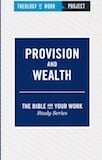Lessons from Elite Leaders: Religious Identity as a Source of Coherence, Part 7 of 8
Blog / Produced by The High Calling
Part 1 | Part 2 | Part 3 | Part 4
Part 5 | Part 6 | Part 7 | Part 8
Personal identity in the modern world is so fragmented that people often assume professional success and personal faith are incompatible. For evangelicals, nothing could be further from the truth.
Laity Leadership Institute Senior Fellow D. Michael Lindsay was the teaching assistant under (the late) sociologist Suzanne Keller for a class at Princeton University called “Elites, Leadership, and Society.” During their work together, Lindsay suggested to Keller that she consider the relevance of faith in the lives of elite leaders.
Keller responded, “None of those people are religious.”
He told her he didn’t believe that and said he thought faith commitments are important to many leaders.
She replied, “If you could prove that, it would be a book worth reading.”
The conversation was the catalyst not only for Lindsay’s dissertation, but also for the research that led to his Pulitzer-Prize-nominated book, Faith in the Halls of Power: How Evangelicals Joined the American Elite (Oxford, 2007).
In a 2009 article in the Journal of Religious Leadership, Lindsay reported on why, compared to many other religious groups, evangelicals’ religious identity tends to be comprehensive rather than compartmentalized.
“For American evangelicals, religious identity is often the source of coherence for their personal identities,” Lindsay wrote. He said this is because making a decision to follow Christ is central to evangelical faith. Converts are often admonished to make Jesus “Lord of their lives” in a way that is all encompassing. This is why notions of calling and faith/work integration are integral to evangelical narratives about public leadership.
Lindsay noted, however, that the complexity and fragmentation of modern life generate many points of intersection among different identities. This complexity forces people to “create hierarchies in their identity construction.”
“People seek coherence in trying to maintain the fragile stability of their selves, and for the devout, identity tends to cohere in religious commitment,” he wrote.
Although some surely prefer that evangelicals leave their faith convictions at home when they step into the public square, Lindsay considers such compartmentalization not only impractical, but undesirable: “Salient forms of identity have empowered groups such as women and people of color to join elite ranks and achieve legitimacy for their respective movements—which society recognizes as a collective good since it has occurred—so why would we feel any different about religious identity?” he wrote.
Lindsay warned, however, that there are “right” and “wrong” ways to draw upon one’s faith in public life. He recommended a cosmopolitan form of civil engagement as a way to build bridges.
“In the process, [evangelicals] will encourage others to retain their unique identities and bring them into the ongoing public conversation,” he concluded.
Understanding our own motivations can help us gain confidence about our convictions and communicate them clearly to others. In this article, Lindsay helps us to see that our mandate to do everything as unto the Lord (1 Corinthians 10:31) is a key reason why our religious identities permeate all aspects of our lives, including our professional lives.
Have you ever thought about faith/work integration or religious identity this way?
If so, how would you explain it to a coworker or client?
If not, does it help to have someone explain it, so that you can own it?
D. Michael Lindsay is a Senior Fellow at Laity Leadership Institute. He is Assistant Professor of Sociology atRice University and Director of the Program for the Study of Leadership. He is also author of the Pulitzer Prize nominated Faith in the Halls of Power: How Evangelicals Joined the American Elite![]() . For this eight part series of lessons from elite leaders, The High Calling talked to Lindsay about his new PLATINUM Study, for which he has conducted 500 interviews. Image by Tim Miller. Used with permission, via Flickr.
. For this eight part series of lessons from elite leaders, The High Calling talked to Lindsay about his new PLATINUM Study, for which he has conducted 500 interviews. Image by Tim Miller. Used with permission, via Flickr.





